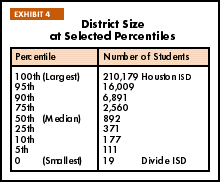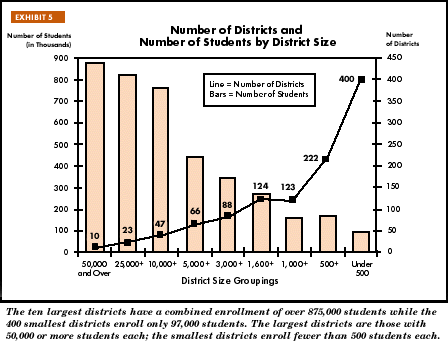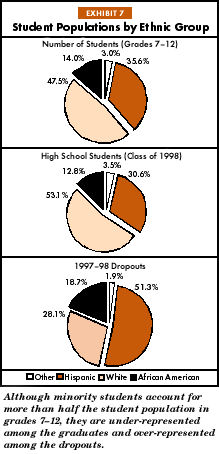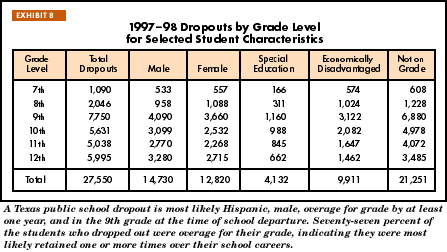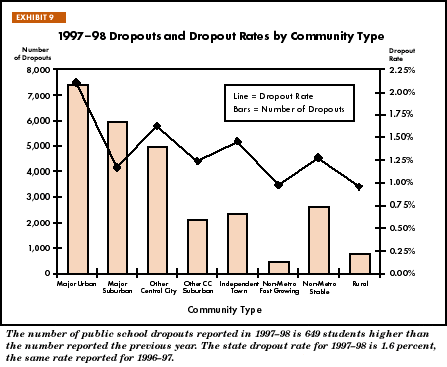|
DiversityThe 3.95 million public school students in Texas are served in markedly diverse school settings. For example, in 1998-99 only 19 students attended school in the Divide Independent School District located in south central Texas, while over 210,000 students received instruction at 296 school sites in the Houston Independent School District, the largest district in the state. The ten largest districts, those with at least 50,000 students each, serve 22.2 percent of all Texas public school students, while the smallest districts (i.e., districts with fewer than 500 students each) represent 36.3 percent of all districts but enroll only 2.5 percent of the state's students. The inverse relationship between the number of districts and the number of enrolled students is a defining characteristic of the Texas public school system. See Exhibit 4 and Exhibit 5 below.
The ethnic distribution of students varies greatly across the state and depends in part on geography, size of the district, and type of community served. Statewide, 55.9 percent of all students are from minority ethnic groups. A minority student is defined as a member of the African American, Hispanic, Native American, or Asian/Pacific Islander ethnic groups. Districts in major urban areas serve an 81.3 percent minority student population while districts in rural areas serve a population that is only 32.8 percent minority. By far the largest minority student group within the state is the Hispanic student population, which represents 38.6 percent of all students. The highest percentages of Hispanic students are found in the Edinburg ESC region at the southernmost tip of the state (95.1 percent), and in the El Paso region in far west Texas (84.2 percent). The largest percentage of African American students, 30.8 percent, is in the Beaumont region east of Houston. The eastern, northern, and north central parts of the state have the highest percentages of White students, varying between 60.5 and 75.0 percent in these areas. The proportion of students from homes experiencing economic hardship also varies across the state. Although the State of Texas does not levy personal income taxes and has little information about family earnings, student eligibility to participate in the national free or reduced-price lunch program is the one indicator of student economic status available for all students. Districts report that 48.5 percent of Texas public schoolchildren, the same percentage as last year, were eligible to participate in this program for the 1998-99 school year. Higher concentrations of economically disadvantaged students are found in major urban districts and in districts with high percentages of minority students. The lowest percentages of economically disadvantaged students are found in districts that are suburban to major urban areas and in districts considered to be non-metro "fast growing." Generally speaking, districts with lower property wealth have higher percentages of economically disadvantaged students. Student participation in special instructional programs differs by community type, district size, and geographic location. For example, rural districts have the highest percentage of students participating in career and technology courses--26.2 percent compared with 15.6 percent in major suburban districts. The highest percentages of students served in bilingual or English as a second language (ESL) programs are enrolled in the Edinburg and El Paso service center regions, with 36.5 percent and 25.4 percent, respectively. These figures are well above the state average of 12.1 percent for those programs. The largest districts also report above average percentages in bilingual or English as a second language (ESL) programs. The statewide percentage of students participating in special education programs grew by 0.1 percent in 1998-99. Districts identified 476,712 students, or 12.1 percent of all students, as receiving some type of special education service, compared to 12.0 percent in 1997-98. There is little variation in the percent of special education students served across the various district grouping categories. The larger and more urban districts tend to show slightly lower percentages of special education students among their total student population than the smaller, rural districts do. Student Population GrowthIn 1998-99, public schools in Texas served 3,945,367 students in pre-kindergarten through grade 12. This total student count represents a 1.4 percent increase from the prior year, which is the smallest rate of increase since 1991-92. The number of charters in operation in Texas increased by 42 (from 19 to 61) between fall 1997 and fall 1998. Although the total membership in charters increased by over 200 percent to 12,226 in 1998-99, the average school size decreased from 203 to 200 students per charter. Most charters operate only one school; among the 61 charters, only four have more than one school site. Of all students enrolled for the 1998-99 school year, approximately 84 percent were served the previous year and the remaining 16 percent were newly enrolled students. This 16 percent includes students entering school for the first time (e.g., pre-kindergarten and kindergarten enrollees) as well as other students entering the Texas public education system, such as those from private schools or residents new to the state. The percentage of new students increased almost two percentage points from 1997-98. While the majority of districts still continue to show enrollment increases, the actual percentage of districts experiencing growth is smaller than in previous years. For 1998-99, 51.7 percent of districts reported enrollment growth while 60.3 percent reported increases in 1997-98. Districts classified as "non-metropolitan fast growing" and districts located in areas that are suburban to major urban districts continue to demonstrate higher than average growth, a 4.5 and 2.7 percent enrollment increase, respectively, as compared to the state average of 1.4 percent. In contrast, rural districts as a group decreased 1.3 percent in size from the prior year. As shown in Exhibit 6 below, growth in the minority student population continues to exceed non-minority grow. Minority students now comprise 55.9 percent of the public school population, compared with 55.0 percent in 1997-98.
Overall, growth in the minority student population was 2.9 percent, with the greatest increase, 6.0 percent, occurring in the Asian/Pacific Islander and Native American populations. However, these two populations, categorized in this document as a single group labeled "other," account for only 2.8 percent of all students. The number of African American students grew by 1.5 percent, representing a net increase of 8,290 students, which is smaller than the increase of 10,690 experienced last year. The percent of African Americans among the total student population is 14.4 percent, the same percentage as in 1997-98. The Hispanic student growth rate, 3.2 percent, exceeds last year's growth rate of 3.0 percent for this student group. Although this rate of growth is not the highest among the ethnic groups, it is the most significant. Of the 53,490 student increase in Texas' total enrollment, 89.3 percent, or 47,761 students were Hispanic. This population now accounts for 38.6 percent of the total number of students. In contrast, the White population dropped by 0.5 percent, or by 8,871 students. The percentage of White students statewide has consistently dropped, falling from 49.0 percent seven years ago to 44.1 percent this year. The reduction in the percent of White students in the total student population over the last several years is attributable to the increasing growth rates of minority students relative to the growth exhibited by the White student population. Growth by GradeAt the state level, all grades except early childhood (early childhood programs other than state-approved pre-kindergarten and kindergarten) reported some growth for the 1998-99 school year. When the populations of the same grades are compared between this year and last, grades 11 and 12 demonstrated some of the highest rates of growth. This was also true in 1997-98. Grade 11 grew 2.9 percent, contributing a gain of 6,730 students and grade 12 experienced a 2.7 rate of growth, with an increase of 5,575 students. Growth in these grades can be partially explained by the effect of a large increase in the number of 5th, 6th, and 7th graders seven years ago who have progressed to these upper grades. The state total enrollment for early childhood education decreased by 506 students to 13,869, a 3.5 percent decline. By far the largest number of students new to the Texas public schools are children entering pre-kindergarten and kindergarten. Over 291,000 students entered public schools at these two grade levels in 1998-99 and they represent 46.4 percent of all new students. Other than pre-kindergarten and kindergarten, grades 1 and 9 also have a large percentage of new students. Almost 13 percent of all 1st graders and nearly 12 percent of all 9th graders are students who were not enrolled in Texas public schools the prior year. These grades are traditional entry points for students previously enrolled in private schools. On average, pre-kindergarten and kindergarten have higher percentages of minority students, 65.7 percent, than the total student population (55.9 percent). Statutory requirements for pre-kindergarten education stipulate that limited English-proficient (LEP) or economically disadvantaged pupils are among those who must be identified and served in pre-kindergarten. These student characteristics are highly correlated with ethnicity in Texas. In grades 1 through 5, the ethnic distribution remains very similar to the state averages, while the secondary grades (grades 6-12) have slightly more White students, 47.1 percent compared with 44.1 percent statewide, and slightly less Hispanic students, 35.9 percent compared with 38.6 percent statewide. DropoutsData for students who drop out of Texas public schools are collected in the fall following the year the students left school. Thus, dropout data reported in the 1998-99 edition of Snapshot reflect students who dropped out during the 1997-98 school year or during the summer of 1998. During that reporting period--August 1997 through October 1998--27,550 students in grades 7-12 were reported and counted as dropouts from Texas public schools. This is an increase of 649 dropouts from the previous year. The annual dropout rate for 1997-98 remains the same as the previous year, 1.6 percent. These dropout statistics are those used for the 1999 accountability ratings. The accountability system definition of a dropout excludes some categories of students, such as those previously counted as a dropout or those found enrolled in public school elsewhere in Texas. Both the Hispanic and African American student groups continue to be disproportionately represented among dropouts. As shown in Exhibit 7 below, 70.0 percent of all dropouts are either Hispanic or African American.
Overall, the percent of total dropouts who are minorities increased slightly to 71.9 percent, compared with 70.7 percent in 1996-97. Furthermore, dropout rates for both Hispanic and African American students remain higher than the state average of 1.6 percent. The Hispanic and African American annual rates were 2.3 percent and 2.1 percent, respectively. The dropout rate for Asian/Pacific Islanders and Native Americans combined was 1.1 percent, and White students had a dropout rate of 0.9 percent. The 12th grade dropout rate was highest, at 2.6 percent, followed by a rate of 2.1 percent for both 9th and 11th graders. In terms of raw numbers, however, more students drop out in 9th grade, 7,750 versus 5,995 in 12th grade and 5,038 in 11th grade. The 1997-98 dropout rate reported for 10th graders was 2.0 percent, which represents 5,631 dropouts. Thirty-six percent of all dropouts are identified as economically disadvantaged, and 77.1 percent are overage for their grade. Consistent with data reported over the last nine years, more males than females dropped out during 1997-98 (53.5 percent versus 46.5 percent). See Exhibit 8 below. Urban districts and districts with high percentages of minority students have the highest dropout rates. Exhibit 9 below depicts the relationship between community type and dropout rates. Both minority students and economically disadvantaged students are found in greater numbers in urban areas, which may partially explain why these rates are higher than the state average.
In addition to the annual dropout rate, the TEA is now able to compute a longitudinal dropout rate by using six years of PEIMS data collected at the individual student level. This measure follows a cohort of 7th grade students from 1992-93 through their expected graduation date with the class of 1998. The number of students in the cohort whose final status is a dropout is divided by the final number of students in the cohort after six years, allowing for in- and out-migration. For the class of 1998 the actual longitudinal six-year dropout rate was 14.7 percent. Among the student groups, Hispanic students demonstrated the highest longitudinal dropout rate, 20.4 percent, compared to a low of 9.0 percent for White students. Longitudinal dropout rates are available as item 15 in the District Detail and Charter Detail. Graduates and Completion RatesAs with the dropout data, information for graduates of Texas public schools is collected in the fall following the year of graduation. During the 1997-98 school year, 197,186 seniors graduated as the class of 1998 from Texas public schools. This count is an increase of 8.5 percent over the class of 1997 graduates. Of the class of 1998 graduates, 18,270 were identified as special education students. Statewide, White students accounted for 53.1 percent of all graduates, Hispanic students 30.6 percent, African American students 12.8 percent, and Asian/Pacific Islander and Native American students the remaining 3.5 percent. See Exhibit 7 above for a disaggregation of the ethnic groups for the 7th-12th grade student population, graduates, and dropouts. Students in Texas public schools who exceed the minimum graduation requirements may graduate with an "Advanced," "Advanced with Honors," "Recommended High School Program," or "Distinguished Achievement Program" diploma. The requirements for each type of diploma are defined by the SBOE. For the class of 1998, graduates with either of the "Advanced" diploma types totaled 60,737, an expected decrease from the prior graduating class. Conversely, the number of students graduating under the Recommended High School/Distinguished Achievement Programs was 17,118 for the class of 1998, which represents an increase of approximately 15,000 students over the number who graduated under these programs from the class of 1997. The class of 1998 is the first graduating class for which the Recommended High School Program/Distinguished Achievement Program requirements were in place since the 9th grade year. Counts of participants in these programs are expected to continue to increase significantly as the older "Advanced" and "Advanced with Honors" diplomas are phased out. While the TEA does not compute a graduation rate, a measure of school completion is available and is now included in the District Detail and Charter Detail as Item 17. The class of 1998 completion rate tracks the cohort of students who were first enrolled as 9th graders in the 1994-95 school year through their expected graduation year of 1997-98. "Completers" are any students who at some time during this time span either graduated or received a General Educational Development (GED) certificate, or were continuing students in 1998-99. For the class of 1998, 91.4 percent were found to have completed school. Of these, 76.7 percent graduated, 7.4 percent received a GED, and 7.3 percent enrolled in a Texas public school in 1998-99. Among the student ethnic groups, Hispanic students have the lowest completion rate, 86.9 percent, which is very close to the rate of 86.3 percent exhibited by economically disadvantaged students. Asian/Pacific Islanders complete at the greatest rate, 96.0 percent. |

